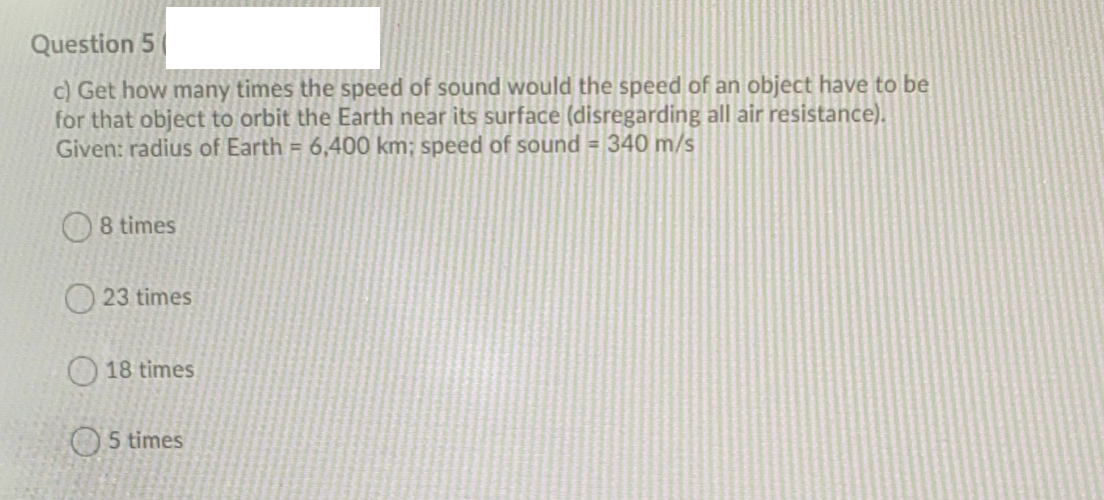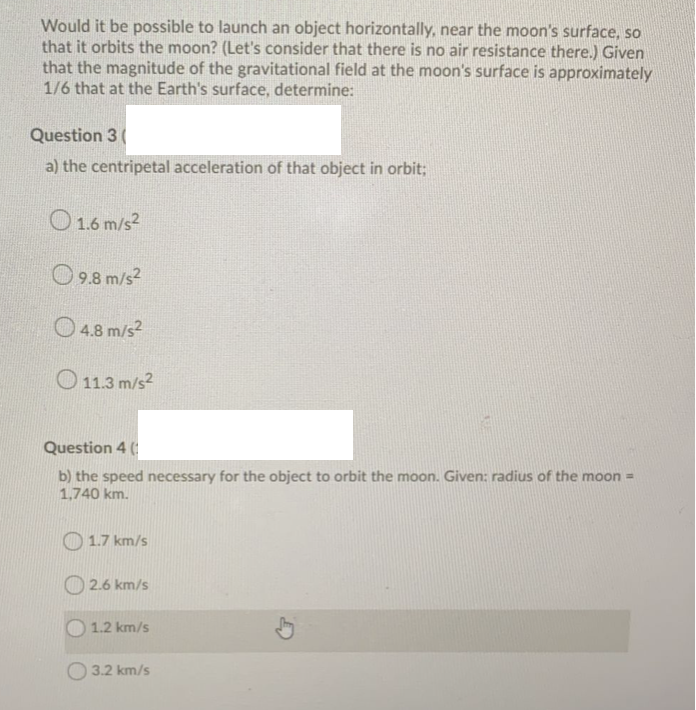Question 5 c) Get how many times the speed of sound would the speed of an object have to be for that object to orbit the Earth near its surface (disregarding all air resistance). Given: radius of Earth = 6,400 km; speed of sound = 340 m/s %3D %3!
Question 5 c) Get how many times the speed of sound would the speed of an object have to be for that object to orbit the Earth near its surface (disregarding all air resistance). Given: radius of Earth = 6,400 km; speed of sound = 340 m/s %3D %3!
Principles of Physics: A Calculus-Based Text
5th Edition
ISBN:9781133104261
Author:Raymond A. Serway, John W. Jewett
Publisher:Raymond A. Serway, John W. Jewett
Chapter11: Gravity, Planetary Orbits, And The Hydrogen Atom
Section: Chapter Questions
Problem 2OQ: The gravitational force exerted on an astronaut on the Earths surface is 650 N directed downward....
Related questions
Question
Pls help ASAP and pls do nicely.

Transcribed Image Text:Question 5
c) Get how many times the speed of sound would the speed of an object have to be
for that object to orbit the Earth near its surface (disregarding all air resistance).
Given: radius of Earth = 6,400 km; speed of sound = 340 m/s
8 times
O 23 times
O 18 times
O5 times

Transcribed Image Text:Would it be possible to launch an object horizontally, near the moon's surface, so
that it orbits the moon? (Let's consider that there is no air resistance there.) Given
that the magnitude of the gravitational field at the moon's surface is approximately
1/6 that at the Earth's surface, determine:
Question 3
a) the centripetal acceleration of that object in orbit;
O 1.6 m/s?
O9.8 m/s?
O4.8 m/s²
O 11.3 m/s?
Question 4 (
b) the speed necessary for the object to orbit the moon. Given: radius of the moon =
1,740 km.
O 1.7 km/s
O 2.6 km/s
1.2 km/s
O 3.2 km/s
Expert Solution
This question has been solved!
Explore an expertly crafted, step-by-step solution for a thorough understanding of key concepts.
Step by step
Solved in 4 steps

Knowledge Booster
Learn more about
Need a deep-dive on the concept behind this application? Look no further. Learn more about this topic, physics and related others by exploring similar questions and additional content below.Recommended textbooks for you

Principles of Physics: A Calculus-Based Text
Physics
ISBN:
9781133104261
Author:
Raymond A. Serway, John W. Jewett
Publisher:
Cengage Learning

University Physics Volume 1
Physics
ISBN:
9781938168277
Author:
William Moebs, Samuel J. Ling, Jeff Sanny
Publisher:
OpenStax - Rice University

Glencoe Physics: Principles and Problems, Student…
Physics
ISBN:
9780078807213
Author:
Paul W. Zitzewitz
Publisher:
Glencoe/McGraw-Hill

Principles of Physics: A Calculus-Based Text
Physics
ISBN:
9781133104261
Author:
Raymond A. Serway, John W. Jewett
Publisher:
Cengage Learning

University Physics Volume 1
Physics
ISBN:
9781938168277
Author:
William Moebs, Samuel J. Ling, Jeff Sanny
Publisher:
OpenStax - Rice University

Glencoe Physics: Principles and Problems, Student…
Physics
ISBN:
9780078807213
Author:
Paul W. Zitzewitz
Publisher:
Glencoe/McGraw-Hill